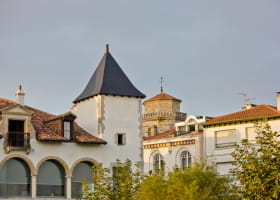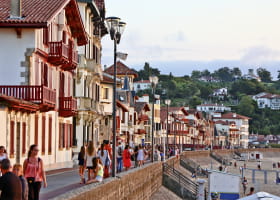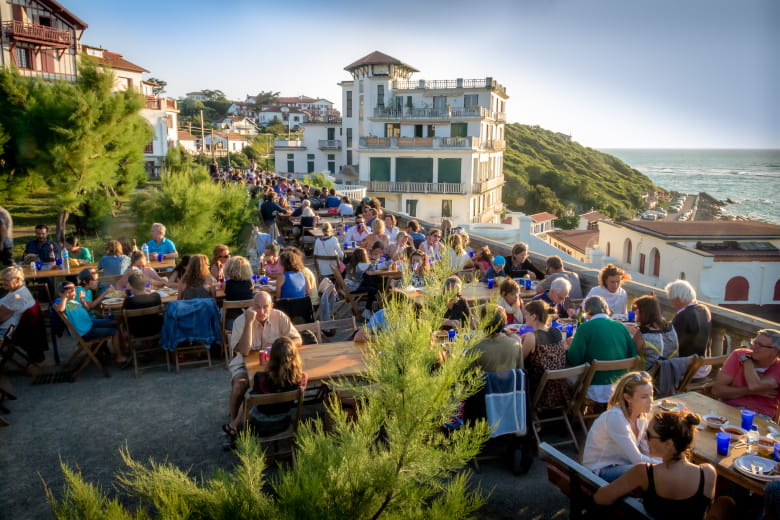
Guéthary: gem of the Basque coast
Getaria
Guéthary, a traditional village located between Bidart and Saint-Jean-de-Luz, is a haven of peace on the doorstep of Basque coastal towns.
An art of living that embraces nature, tradition and "the good life" at the water’s edge awaits you on every street corner and detour down Guéthary’s narrow streets.
Not to be missed
Ezinbestekoak
Agenda
Animazioak
The history of the smallest village on the Basque Coast
Istorioa
Guéthary or Getaria in the Basque language is the smallest village on the Basque Coast. Its Labourdine-style houses, its art-deco buildings and the breath-taking view of the ocean from the Terrasse de la Mer or the church give it a charm to which all visitors succumb.
Herriko Etxea: “the Town Hall house”

As in all Basque villages, the Town Hall “Herriko Etxea” literally “village house” in the Basque language and the fronton are on the main square. The particularity of Guéthary is that its church is located a little higher up and not in the heart of the village.
Indeed, there used to be an old town in the rural area of the town before the current town centre developed.
This neo-Labourdine style town hall with its white facades and red shutters dates back to 1926. It was built by architect Ferdinand Brana, who also built the old Getaria hotel. The town hall hosts the Tourist Information Office, which is open all year round.
One of the largest frontons on the Basque Coast

As for the fronton, it was moved in 1868 because it was an obstacle to the future railway. The date on the wall is 1910 because it was built higher in that year to play grand chistera.
In addition to grand chistera pelota games that take place every Wednesday evening in summer, the fronton also hosts markets on Sunday mornings and flea markets on Saturday mornings from spring to autumn, as well as village festivals and animations proposed by various village associations.
Fishing: from whales to squid
Whaling began on the Basque coast in the 9th century and brought prosperity to the Basque population by developing trade linked to whale blubber, which was then transformed into oil.
Then coastal fishing was set up, in particular, for “xipiroi” also called chipirons or squid. Today, Guéthary harbour is used for recreational fishing. A word of advice: if you get up early, it is very likely that you will see fishing boats returning from sea.
A village facing the ocean and waves
The ocean is everywhere
While out walking, every nook and cranny of the town reminds us that the village faces the ocean. Indeed, whether it is the coat of arms that represents a whale and a whaling boat, the names of the streets, or the view when going higher up town, the sound of the waves during storms... the ocean is present everywhere in Guethary.
The streets inevitably descend towards the ocean, the beach and the small harbour with its dry dock. The small bars and restaurants often provide an ocean view and make this town the ideal place to have a drink or lunch while looking out at the sea.
The coastal path crosses through the village and leads you to small paths that take you very close to the ocean.
The large Terrace overlooking the ocean should not be missed as it is a wonderful place to watch the waves and surfers.
Surfing: a genuine culture in Guéthary

The surfing culture is well established here, thanks to its historic club "Ur Kirola" created in 1967 by enthusiasts. In addition to being a club, it hosts evening events and activities during the summer in connection with the ocean. Surf schools enable you to discover the sport in total safety throughout the year.
You won't be surprised to see surfers strolling through the middle of the village in wetsuits with their boards under their arms, or vans parked near the harbour with boards on the roof.
Several shops related to surf culture can be found in Guéthary such as Hoalen, Southwest Guéthary and Parlementia.
Avalanche and Parlementia are two famous surf spots that welcome local and international surfers. Big names in surfing, such as Laird Hamilton, have come to rub shoulders with the waves of Guéthary.
Avalanche is more of a big wave spot reserved for surfing professionals, while Parlementia is more accessible to beginners.
The Avalanche surf spot, on a day with big waves!

A natural village
A preserved coast with beaches and hiking trails
Guéthary is a village where life is good and nature is preserved. Cenitz Hill is a typical example of this. This nature reserve belonging to the Coastal Conservation organisation and traversed by the Coastal path and the Vélodyssée cycle track is only accessible on foot or by bike and offers an exceptional view of the ocean.
Its particularity: it marks the boundary between the towns of Guéthary and Saint-Jean-de-Luz and overlooks two beaches and their bistros.
Unlike other towns, there is no supervised beach in Guéthary, only small pebble beaches welcoming families and people looking for a quiet environment.
“The good life” and “the good food”
The perfect place to eat fish

On the gastronomy side, the village of Guéthary offers a variety of restaurants ranging from the beach bistro to the Michelin-starred restaurant with an abundant offering of traditional cuisine. The specialty of the restaurants of Guéthary is, of course, fish that each restaurant cooks "in its own way": grilled, in sauce, Spanish style...
But there is one element that all the restaurants and bistros in Guéthary have in common and highlight, and that is quality! Both in terms of produce and the preparation of the different dishes.
Local produce shops and markets
To cook and bring back local products, a short trip to Guéthary market is a Must on Sunday mornings from April to September.
All year round, the Yaoya grocery store offers vegetables from Alatz, an organic market gardener in Guéthary.
La Maison du Fronton offers local, high quality products such as cheese, cold cuts, chocolate... But also "sagarno", an apple wine that is one of the specialties of the Basque Country and “Patxaran”, a liqueur waiting to be tasted.
A village mixing culture and tradition
Basque pelota in the village centre

The fronton located on the village square makes everyone want to try to play Basque pelota or attend a game.
Every Wednesday evening in July and August, the Olharroa Grand Chistera club organizes free games. An opportunity to realize just how fast the ball moves.
It is also on this fronton, the beating heart of the village, that festivals are organized during the last weekend of August. On the menu: meals, concerts with Basque songs, Basque dances... All generations meet here.
"Herriko Ahotsak", the village voices

And as the inhabitants of Guethary love their culture, the “Herriko Ahotsak” event, meaning “village voices”, is organized every year in October. As its name suggests, there are concerts with traditional Basque songs but also traditional Basque dances offered by the village group, Getaria dantza taldea.
The locals meet there to sing, dance and eat a “talo”, a Basque speciality, accompanied by a glass of “sagarno”, apple wine.
Maison Saraleginea: culture in the village centre

In Guéthary, Basque traditions can also be recognized in the "Etxe", Basque or neo-Basque architecture with Labourdine-style houses present throughout the village.
One of the most majestic ones, Saraleginea House, is home to the Guéthary Museum. This contemporary museum dedicated to sculptor De Swicienski, also houses a collection by poet Paul-Jean Toulet as well as remnants dating from Roman times and the history of Guéthary.
The Museum also puts artists in the spotlight by organising exhibitions between May and October.


































